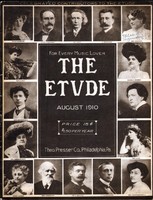London is the world's greatest violin market as regards Cremona violins and string, instruments of artistic excellence generally. There are more real experts in the art of judging old violins in London than in any other city in the world, and the number of dealers and restorers of instruments of this kind is also very great. The London experts, dealers and repairers, have great opportunities for becoming familiar with the violins of the great masters, since there are few really great instruments which have not been through the hands of the London old violin trade, at one time or another in their history.
London is also the only city where regular auction sales of violins are held at frequent intervals. In no place on earth can a genuine old violin by one of the masters be obtained at so small a price, provided one attends the sales regularly, and watches his chance when a fine old masterpiece is going far under ordinary dealers' prices.
The purchaser at such a sale must remember, however, that, as a rule, the instruments are sold as they are, without any guarantee that the labels are authentic, or that the violins are what they purport to be. The purchaser must be an expert judge of violins, or else he is likely to get "stung" with a violin which purports to be a "Strad," or a "Guarnerius," or an "Amati," and which turns out to be really the product of an obscure Italian or French maker. To a really expert judge, however, the London auction rooms offer splendid opportunities of buying fine instruments at real bargain prices.
A RECENT AUCTION SALE.
At the last auction sales at the rooms of Puttick & Simpson, in London, a large number of violins were sold at the following prices, which have been reduced to terms of American money: A violin by Antonius Stradivarius, with original label, $2,875; a violin by Grancino, $230; a violin by J. B. Vuillaume, with silver-mounted bow, $130; a violin by Landolfi, Milan, $200; a violin by Montagna, with one gold- mounted and one silver-mounted bow, $330; a violin by J. B. Gabrielli, Florence, 1747, $230; a violin by Testore, Milan, 1693, $225; a violin by Andreas Guarnerius, 1632, $850; a violin by Nicolas Lupot, Paris, 1810, $225; a violin by Antonio Gragnani, $230; a violin by Joseph and Antonius Gagliano, 1768, $300; a violin by Nicolas Amati, $300; a violin by Nicolas Amati, 1675, $325; a violin by G. B. Ruggeri, $140; a violin by Mathias Albanus, 1672, $145; a quarter-sized violin by Antonius Stradivarius, $210; a violin by B. G. Rogeri, of Brescia, 1704, $160; a violin by Nicolas Lupot, Paris, 1798, $375; a violin by Joseph, filius Andreas Guarnerius, 1700, $800; a Mathias Albanus, $225; a Landolfi, of Milan, $160; a Ceruti, of Cremona, $160; a Francesco Ruggerius, $330; a violoncello by Ferdinando Gagliano, $375; a violin by Testore, of Milan, $330; a J. B. Vuillaume, $170; a Petrus Guarnerius, Mantua, $500; a violin by Maggini (head not original), $350; a violin by A. and H. Amati, Cremona, $700; a Testore, $270; a Sanctus Seraphino, $275, and a number of other violins of lesser note. The total proceeds of the one day's sales were over $18,500.
Another firm had an auction sale of violins, 'cellos, etc., within two weeks of the above sale, at which a large number of instruments were sold at a similar range of prices, and showing what an immense market there is for old violins in London. There are at least two such sales a month throughout the season.
The prices realized for the instruments, as given above, will strike the American reader as being extraordinarily low, but he must remember that, some of the violins quoted above may not be genuine, nor may they all be good specimens of the maker's work, even when genuine. Some, again, may be in poor preservation, or have been scraped or otherwise spoiled by restorers or repairers. The American reader must also remember that there is a heavy import duty on violins brought into this country, and that the large numbers of violins, and collections of violins constantly being broken up in Europe, make violins cheaper there.
These London sales attract violin dealers from all over the world, and remarkable bargains can occasionally be picked up.
The fact that one part of a piece of music may be less difficult is no reason why that part should be played faster than the, rest of it. Neither are technical difficulties a reason for playing such a part slower. However, in most instances where technical difficulties occur, there is also harmonical crowding, and in such cases a ritardando is permissible.—C. H. Richter.



